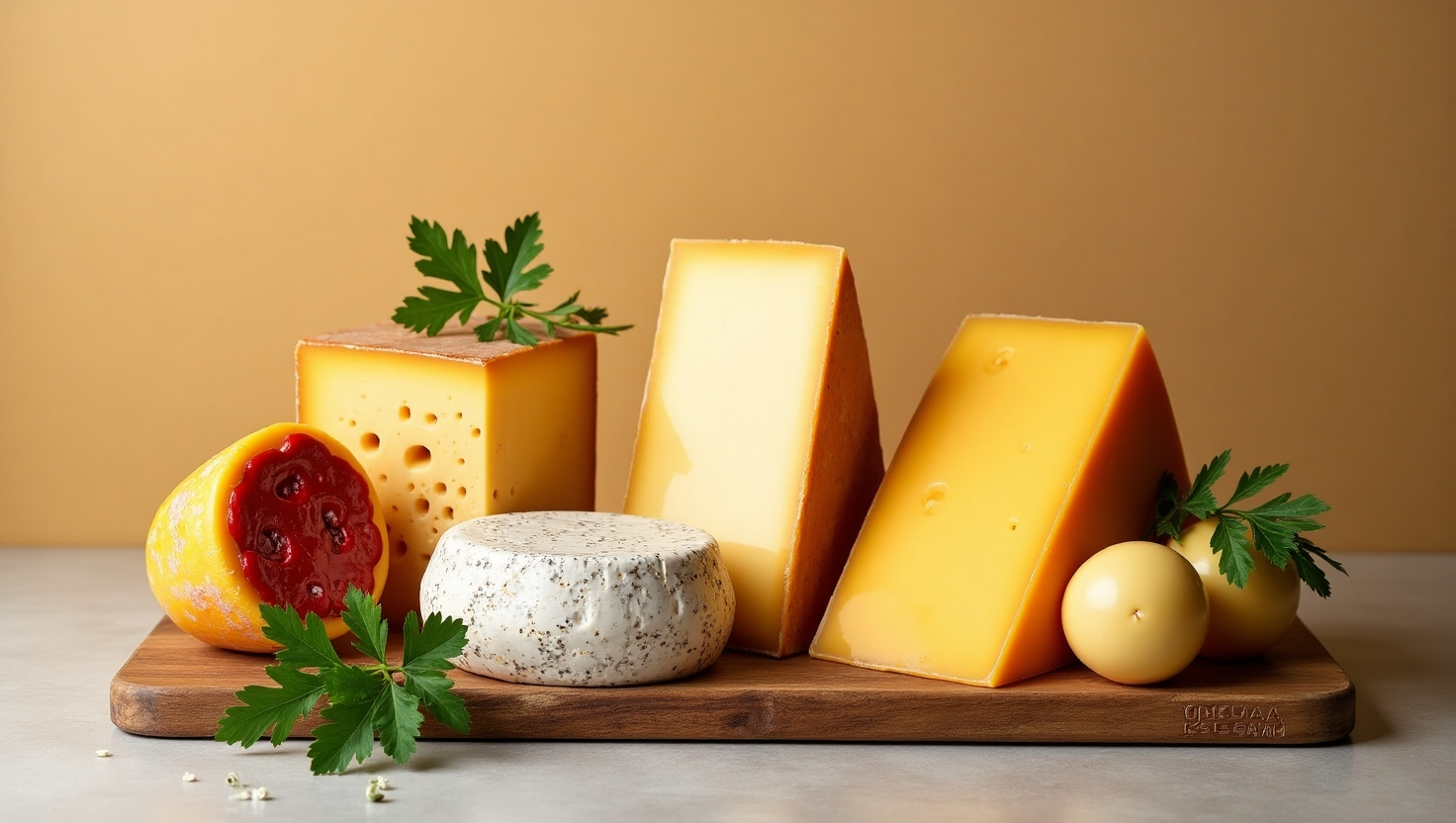Introduction
When it comes to cheese, the Netherlands is a true treasure trove. Renowned worldwide for its exceptional dairy products, Dutch cheese has a history and tradition as rich as its flavors. From creamy and mild to sharp and aged, Dutch cheeses cater to all palates. This guide dives into the top five Dutch cheese varieties that you absolutely must try, each bringing its own unique flavor profile and culinary versatility.
Table of Contents
1. Gouda: The Pride of Dutch Cheese
Gouda (pronounced “How-dah” in Dutch) is arguably the most famous Dutch cheese. Its versatility and delightful flavor make it a global favorite.
Characteristics
- Texture: Creamy when young, crumbly when aged.
- Flavor: Mild and buttery in its younger stages; rich, nutty, and caramel-like when aged.
- Aging Process: Can age from a few weeks to over a year.
Culinary Uses
- Young Gouda: Perfect for sandwiches, burgers, or melting over dishes.
- Aged Gouda: Best enjoyed on its own or paired with wine and fruit.
Pairing Suggestions
- Young Gouda: Pairs well with light white wines like Sauvignon Blanc.
- Aged Gouda: Complements robust reds such as Cabernet Sauvignon or even sweet ports.
2. Edam: A Mild and Creamy Delight
Edam cheese, known for its signature red wax coating, is a milder and creamier alternative to Gouda.
Characteristics
- Texture: Semi-hard, smooth, and creamy.
- Flavor: Mild with a slightly nutty aftertaste.
- Aging Process: Typically aged for 1-3 months, but aged versions develop a sharper flavor.
Culinary Uses
- Melted over baked dishes.
- A key ingredient in quiches and savory pies.
- Enjoyed as a simple snack with crackers.
Pairing Suggestions
- Perfect with crisp white wines such as Pinot Grigio or Riesling.
- Complements fresh fruits like apples or pears.
3. Maasdam: The Dutch Answer to Swiss Cheese
Maasdam cheese is a lesser-known gem, often compared to Swiss Emmental due to its holey appearance and sweet flavor.
Characteristics
- Texture: Semi-soft and slightly elastic.
- Flavor: Sweet, nutty, and buttery, with a hint of fruitiness.
- Aging Process: Typically aged for 4-12 weeks.
Culinary Uses
- Great for melting in fondues or over casseroles.
- Delicious in sandwiches and grilled cheese.
Pairing Suggestions
- Pairs well with light beers or fruity white wines like Chardonnay.
- Serve with nuts and dried apricots for a perfect appetizer platter.
4. Leyden: A Spicy and Aromatic Treat
If you enjoy a cheese with a bit of a kick, Leyden cheese (Leidse Kaas) is the one to try. Infused with cumin or caraway seeds, this cheese is uniquely flavorful.
Characteristics
- Texture: Firm and crumbly.
- Flavor: Savory with a distinct spicy note from the added seeds.
- Aging Process: Typically aged for 1-3 months.
Culinary Uses
- Adds a burst of flavor to sandwiches and wraps.
- Crumbles beautifully over salads or baked potatoes.
Pairing Suggestions
- Best paired with dark beers or robust reds like Shiraz.
- Complements hearty bread and olives.
5. Boerenkaas: Traditional Farmhouse Cheese
Boerenkaas, or “farmer’s cheese,” is an artisanal product made using traditional methods. It is often crafted from raw milk, giving it a rich and authentic flavor.
Characteristics
- Texture: Firm but creamy.
- Flavor: Varies based on the milk and aging process but is often bold and complex.
- Aging Process: Aged from a few months to over a year.
Culinary Uses
- Shredded over pastas or soups for added richness.
- Sliced thinly for charcuterie boards.
Pairing Suggestions
- Pairs beautifully with craft beers or aged spirits like whiskey.
- Serve alongside cured meats and honey for a balanced flavor profile.
How Dutch Cheese Is Made
The meticulous cheesemaking process in the Netherlands reflects centuries of tradition:
- Milk Collection: High-quality milk from cows, goats, or sheep is used.
- Curdling: Rennet is added to curdle the milk, separating it into curds and whey.
- Pressing: The curds are pressed into molds to shape the cheese.
- Salting: The cheese is soaked in brine to enhance flavor and preservation.
- Aging: The cheese is aged in controlled environments, allowing flavors to develop.
Why Dutch Cheese Stands Out
Dutch cheese is renowned for its:
- High Quality: Strict regulations ensure exceptional standards.
- Diversity: Offers a variety of flavors and textures to suit every palate.
- Cultural Significance: Integral to Dutch heritage and culinary traditions.
How to Store Dutch Cheese
Proper storage ensures your Dutch cheese stays fresh and flavorful:
- Refrigerate: Wrap cheese in wax paper or parchment, then place it in an airtight container.
- Avoid Freezing: Freezing can alter the texture, making it crumbly.
- Use Quickly: Consume within 1-2 weeks after opening for the best taste.
FAQs About Dutch Cheese
What makes Dutch cheese unique?
Its combination of traditional techniques, high-quality ingredients, and diverse flavor profiles makes Dutch cheese a standout.
Can you eat the wax coating on Edam cheese?
No, the wax is inedible and should be removed before eating.
How do I use aged Gouda in recipes?
Grate it over pasta, soups, or roasted vegetables for an added depth of flavor.
Is Dutch cheese lactose-free?
Aged Dutch cheeses are naturally low in lactose and can be easier to digest for those with lactose sensitivity.
Conclusion
Dutch cheese offers an unparalleled experience for cheese lovers. From the creamy Gouda to the spicy Leyden, each variety tells a story of tradition, flavor, and versatility. Whether you’re savoring it on its own, incorporating it into recipes, or pairing it with wine, Dutch cheese is a culinary delight that deserves a place in your kitchen.
So why wait? Explore these five Dutch cheese varieties and discover a new favorite today. Your taste buds will thank you!
